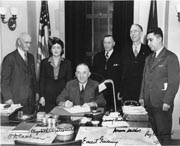Ernest Gruening

With his appointment in 1934 as director of the Division of Territories and Island
Possessions within the Department of the Interior under President Franklin D. Roosevelt,
Gruening worked to improve conditions for United States citizens outside the continental
boundaries. Almost immediately he began working toward statehood for Alaska and Hawaii.
Roosevelt appointed Gruening as governor of the Territory of Alaska in 1939 and twice reappointed until 1953. Gruening, known as "the father of Alaska statehood" was elected to the United States Senate on November 25, 1958, and on January 3, 1959, Alaska was admitted as a State into the Union.

Gruening fought for statehood, for an expanded economic base, for protection and efficient utilization of resources, and for equality for Alaskan Natives. As a U.S. Senator after Alaska achieved statehood, Gruening worked to smooth the transition. He provided leadership at the national level in support of civil rights, in improving U.S. foreign aid, and in efficient utilization of natural resources. Gruening continued as a Senator until 1969 after being reelected in 1962.
After an unsuccessful renomination in 1968, Gruening became president of an investment firm and a legislative consultant.
Always a strong supporter of the University of Alaska while serving as governor of the Territory of Alaska, Gruening was awarded an honorary degree by the university in 1955 in recognition of that support. He and his wife, Dorothy, attended the dedication of the Ernest Gruening Building on the Fairbanks Campus in 1972.
Gruening died on June 26, 1974, in Washington, D.C. He was cremated and his ashes was scattered over Mount Ernest Gruening, north of Juneau, Alaska.
Books by Ernest Gruening include "The State of Alaska," "The Battle for Alaska Statehood," "Mexico and Its Heritage," "The Public Pays, Viet Nam Folly," and his autobiography, "Many Battles." He was also a contributor to numerous periodicals including National Geographic, The Nation, The New Republic, The Atlantic Monthly, as well as the Encyclopedia Britannica.

UA Site named after Ernest Gruening
Ernest Gruening is also mentioned in these articles
Sources:
Biographical Directory of the United States Congress
